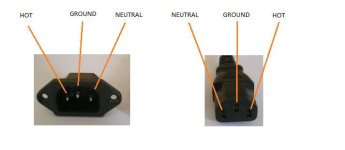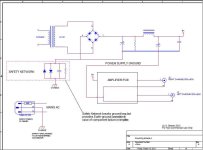"Can this approach help?"
Maybe ... maybe not.
If you use shielded RCA cable (probably shield connected to RCA "cold" in both end and to possible metal part of RCA plug also) AND the preamp output and power amp input RCA sockets are both connected to own metal part of box (where mains safety grounds also connected), the hum loop may appeared.
Try to interrupt this loop.
------------------------
BTW I never use such equipment where input/output RCA sockets tied to metal box!
-----------------------
First of all, use same power distributor for monoblocks and preamp.
Both mains IEC plug phase and neutral position would be the same. If one of them differs, change the mains plug orientation.

Try it.
Is hum decreased?
Use such RCA cable -with hot and cold wire- , where shield connected to only one end to RCA cold...or unshielded.
1.) Connect monoblock inputs together via RCA cable.
Is there any hum?
If no hum, the power amps grounding path are OK.
2.) Connect only one monoblock to preamplifier. Preamplifier input RCAs are remain empty (shorting if possible), volume controller unwound.
Is there any hum?
3.) If 2.) is OK, connect another monoblock via RCA cable to preamp.
Is there any hum?
BTW @lcsaszar recommended hum-loop breaker IMHO is essential on all DIY devices.

Maybe ... maybe not.
If you use shielded RCA cable (probably shield connected to RCA "cold" in both end and to possible metal part of RCA plug also) AND the preamp output and power amp input RCA sockets are both connected to own metal part of box (where mains safety grounds also connected), the hum loop may appeared.
Try to interrupt this loop.
------------------------
BTW I never use such equipment where input/output RCA sockets tied to metal box!
-----------------------
First of all, use same power distributor for monoblocks and preamp.
Both mains IEC plug phase and neutral position would be the same. If one of them differs, change the mains plug orientation.

Try it.
Is hum decreased?
Use such RCA cable -with hot and cold wire- , where shield connected to only one end to RCA cold...or unshielded.
1.) Connect monoblock inputs together via RCA cable.
Is there any hum?
If no hum, the power amps grounding path are OK.
2.) Connect only one monoblock to preamplifier. Preamplifier input RCAs are remain empty (shorting if possible), volume controller unwound.
Is there any hum?
3.) If 2.) is OK, connect another monoblock via RCA cable to preamp.
Is there any hum?
BTW @lcsaszar recommended hum-loop breaker IMHO is essential on all DIY devices.

Do you have alligator clips or test leads with clips on them? You could try clipping device to device first. I really do believe, as others have mentioned, the preamp ground or lifting the preamp ground would help troubleshoot first.Can this approach help?
Ground loops and ground noise are pain. I work on medical equipment and many devices are super sensitive to ground. All medical devices are grounded and we check ground integrity with special meters. We also check equipment [current] leakage. You would be amazed at home leakage Dell monitors have. That is why in clinical treatment areas, we use professional grade monitors. Better power supplies, ground integrity, super low leakage and many are 'splash proof'. Don't even get me started with isolated power. I do an education for new technical staff and it takes a long time for people to understand it. You could have something with high leakage currents interacting with the amplifiers in this situation.
You have a loop somewhere. You need to isolate it. In theory, all your grounds go back to where you plug in your equipment at the wall (and then further back to the electrical panel). Start by lifting the preamp ground as a test and see if that eliminates or reducing the noise with these amps. Yes / No go to the next step by maybe breaking down the system and unplugging everything and just have the Preamp and Amps connected together (without any source components connected to the preamp or even AC power). Step by step...
You could hum buck the input stage of the amp. With reference to a 805C service manual disconnect R8, R9 and the screen of the input from ground and add a 15R resistor from the the new node R8, R9 and the screen to ground. The input connector must be isolated from the chassis. Also check the input cable inside the amp is not running near/over the mains transformer. Its the magnetic coupling of the main transformer into the input cable which is generating your differential hum loop between your two amps. I would not start lifting earths off valve amps.
Last edited:
Just to update on my issue:
I've installed IFI Ground Defender for each monoblock - and it solved the issue almost completely.
https://www.silentpower.tech/products/gnd-defender
I've installed IFI Ground Defender for each monoblock - and it solved the issue almost completely.
https://www.silentpower.tech/products/gnd-defender
Do you still have a proper safety ground with these plugs? What’s inside? Have you measured this?